Orangutans are one of the most intelligent mammals on the planet, second to only humans. Their cognitive abilities come incredibly close to that of humans. There is even evidence of them having the ability to use tools such as using leaves as protection to eat prickly fruits.
Despite the similarities to humans, baby orangutans have a much different upbringing.
Baby orangutans have a very close bond with their mothers. They are highly dependent on the mother, making their upbringing extremely distinct from other mammals. An analysis of their upbringing gives us insight into interesting facts about baby orangutans.
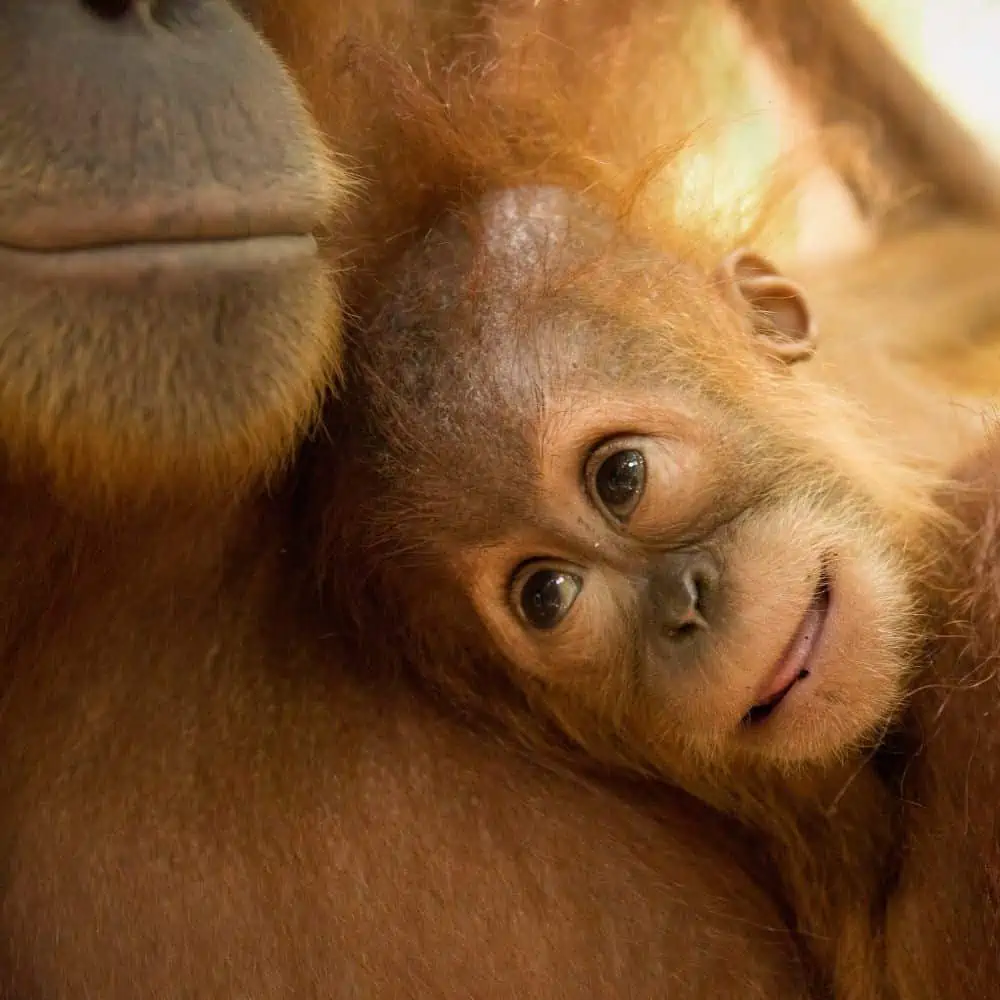
Keep reading to find out how baby orangutans are raised to become highly intelligent great apes and some interesting facts about them.
1. Three species of Orangutans and their offspring
It may be common for people to group all types of orangutans as just one specie. However, this great ape has been subdivided into three different species.
There are the Sumatran orangutans, the Bornean orangutans and lastly, a newfound category, the Tapanuli Orangutans.
The Bornean orangutans are typically smaller than their Sumatran counterpart and have darker-colored hair. The Bornean has been further divided into more categories based on the landscape.

Sumatran orangutans are critically endangered and assisted reproduction has been used to help secure their existence.
In 2014, the first ever baby orangutan was born through artificial insemination (i.e. assisted reproduction). A baby boy named Artie the Orangutan.
2. Social Learning
The orangutan is a brilliant animal that shows signs of complex cognitive ability. However, most of that knowledge may not be innate.
They learn complex skills and essential survival techniques through social interactions.
After mating, the father has a non-existent role in the development of the baby orangutan. The mother, however, has the exact opposite role.
The mother is responsible for taking care of the child and teaching all essential skills to survive in the wild.
3. Delayed dependency
Because the mother has such a pivotal role in the lives of baby orangutans, they have an extended period of dependency compared to most other mammals.
Baby orangutans generally depend on their mother for the first ten years of their lives.
4. Buddy travel
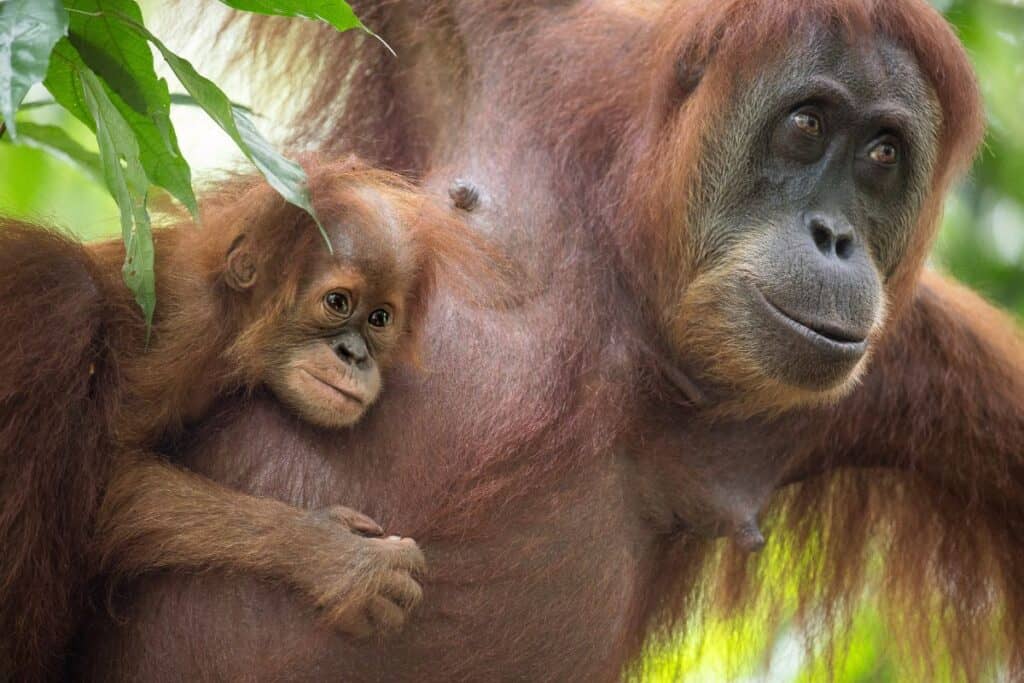
The mother carries her child across the trees and transports them in and out of the nest using the buddy travel method. Here the female orangutan keeps their child close when moving about.
Some mothers will carry their child till the age of five. Others will carry the baby orangutan until two years of age and continue to hold their hand till they turn five.
5. Breastfeeding
Unlike most other mammals, baby orangutans will continue to be breastfed for at least the first eight years of their lives.
By this age, most other mammals have become self-sufficient and independent. However, baby orangutans continue to depend on their mother for food, shelter, and learning skills.
6. Survival techniques
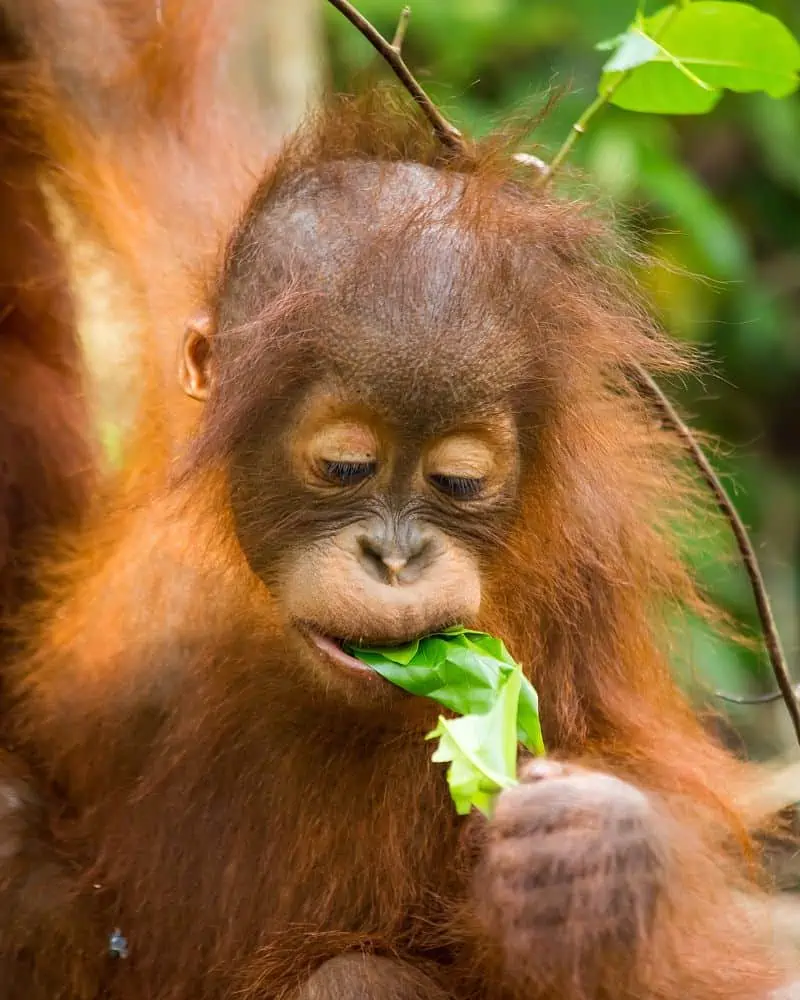
The primary component of a baby orangutan’s diet is fruit. They live high in the trees, which is why they source their food in the trees too.
It is rare for orangutans to come to the ground as it is dangerous and makes them vulnerable to predators. Fortunately, their skillset and bodies allow them to thrive in the trees, so they don’t need to come down to the ground very often.
The only possible time when they do need to travel on the ground is when they have fully matured and become overweight.
For baby orangutans, that is not the case which is why they will rarely be seen traveling on the ground or without their mothers.
7. Use of tools
It can be difficult for young orangutans to retrieve food and eat without a helping hand. Baby orangutans learn to use tools like sticks to retrieve fruits from inaccessible places or to look for insects to eat.
They are also known to use leaves as gloves to eat prickly fruit, so their hands don’t get hurt.
This helps them eat their favorite food like durian, a rather smelly fruit that has a spiky outer skin.
They may also salvage moisture from leaves when water is scarce and use large leaves as shade to protect them from the sun.
All of this is taught to the young orangutans by their mothers.
8. Cultural differences
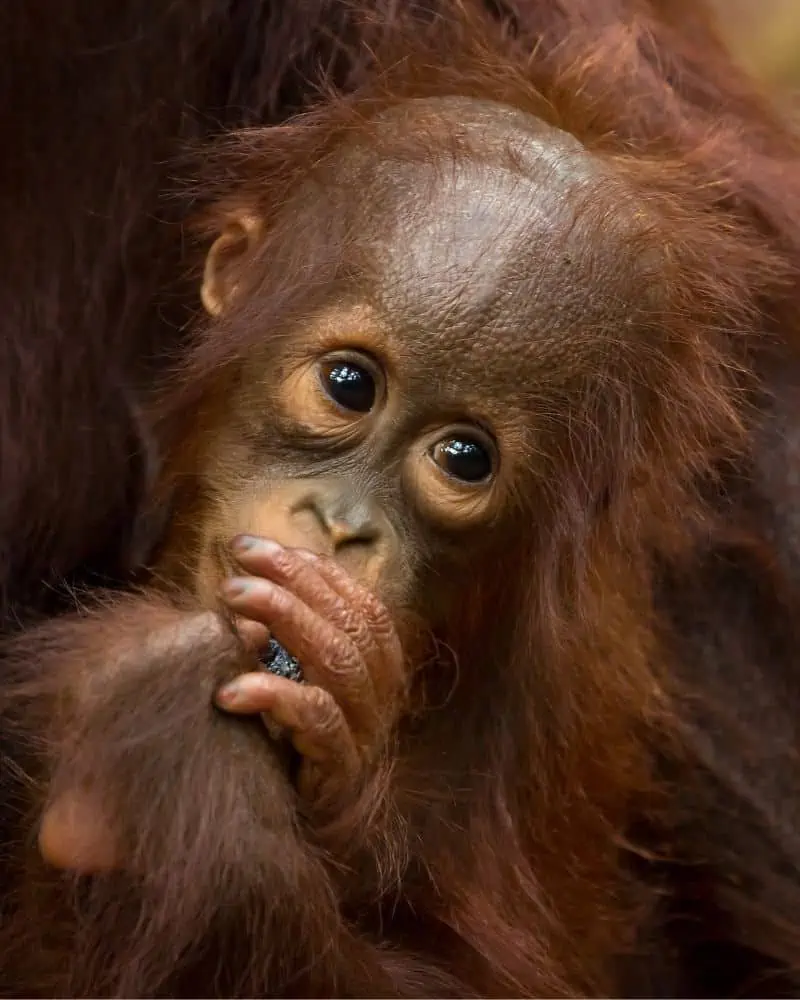
We have already discussed the three different species of orangutans and their physical differences. However, because baby orangutans learn their skills socially, there is also a contrast between the cultures of the communities too.
The knowledge is passed down from their mother to the baby over time. This explains why their norms and practices might differ from one species to another.
A great example is the use of leaves. Borneo orangutans would use leaves as napkins to clean and wipe their chins.
On the other hand, the Sumatran species would use a large pile of leaves as a cushion to sit on or while handling prickly branches or fruit.
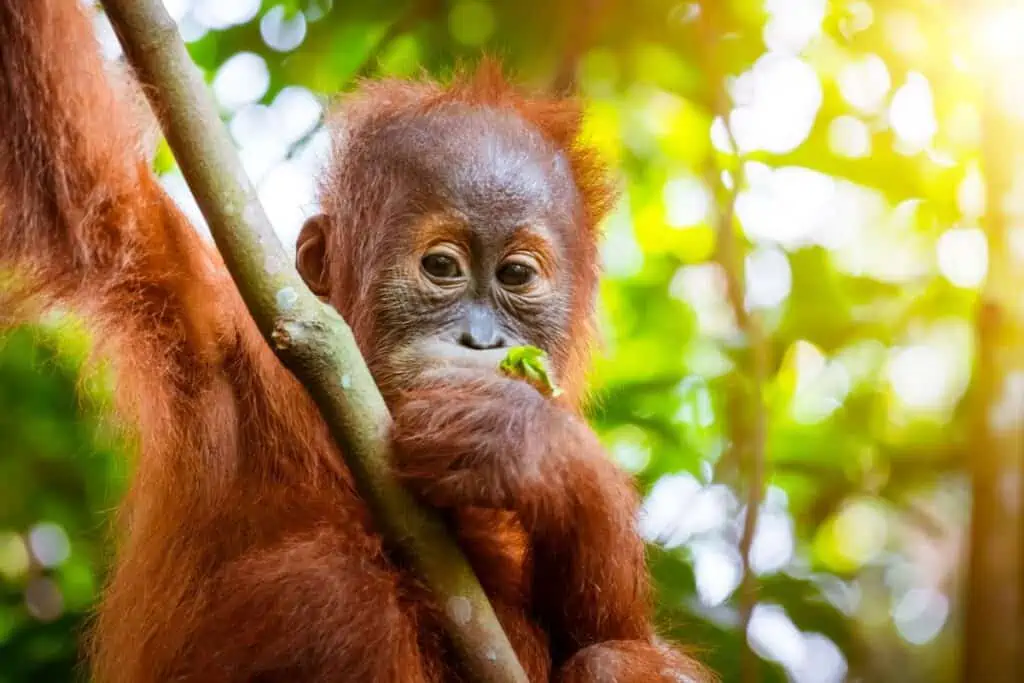
9. Independence
Nearing the age of ten, the baby orangutans reach puberty and mature. It is then that they become slightly more self-sufficient.
They might start to travel alone without their mother and not be dependent on them for food or shelter. However, they still have close bonds with their mother.
This is why, unlike other mammals, orangutans will stay near their mother until they are fully mature.
Now that they have acquired the required skillset and knowledge to survive, orangutans will build their own nests and start foraging for food.
Males will eventually begin to move to different territories to acquire and take over.
On the other hand, female orangutans will continue to stay in the general vicinity of their mother to learn how to take care of their own offspring.
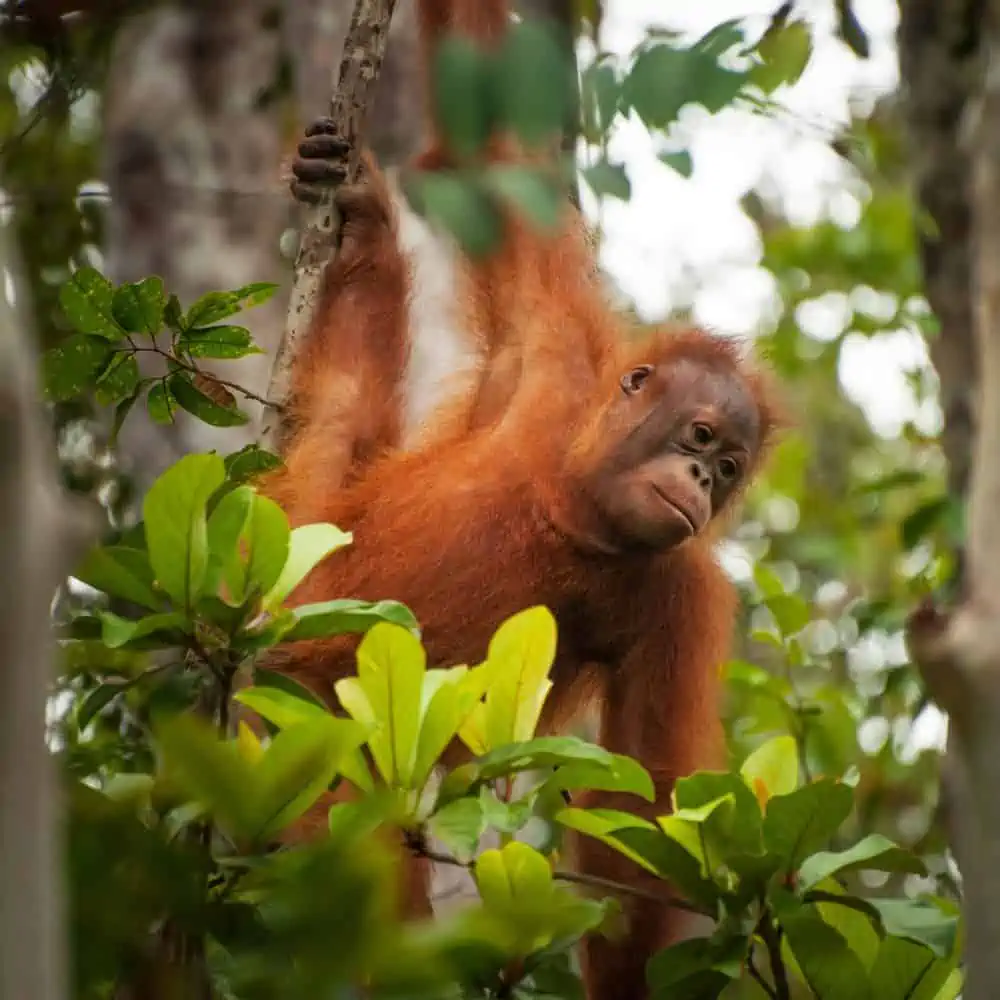
10. Sexual maturity
Orangutans may reach sexual maturity by the age of fifteen when they would have their own offspring. However, only one baby orangutan may be born at one time.
Furthermore, they do not multiply at rapid rates, unlike other mammals.
As their developmental time is prolonged, the mother will not mate again until the baby orangutan is between the age of 8 to 10 years.
Final thoughts on baby orangutans
Orangutans are fascinating creatures and their babies are just as adorable.
We’ve looked at the different skills that baby orangutans learn from their mothers, as well as how they mature and become more independent over time.
It’s amazing to see how these primates adapt to their environment and learn various survival techniques.
They are not just cute but have an immense cognitive ability through which they can learn to perform complex tasks.
It is not just genetics and evolutionary skills but also the unique setup of their communities and culture that make baby orangutans this wondrous mammal.
FAQs
What is a baby orangutan called?
A baby orangutan is called an infant or baby. Like humans, they are born helpless and need their mother’s care to survive.
They stay close to their mother for the first few years of their life, learning how to build nests, find food, and take care of themselves. By the time they reach puberty, they are ready to start living on their own.
How long does it take for a baby orangutan to be independent?
By the age of ten, baby orangutans reach puberty and mature. At this age, they start to travel alone without their mother and not be dependent on them for food or shelter.
Even as they grow up and leave their mother, orangutans still have a close bond with her. In fact, they will stay close even until they reach full maturity, something that other mammals don’t typically do.
How long are orangutans pregnant?
Orangutans are pregnant for around 8 and a half months, almost as long as humans.
Only one child is born at a time, and even though having twins is a possibility for orangutans, it is an infrequent occurrence, with chances of less than 1%.
